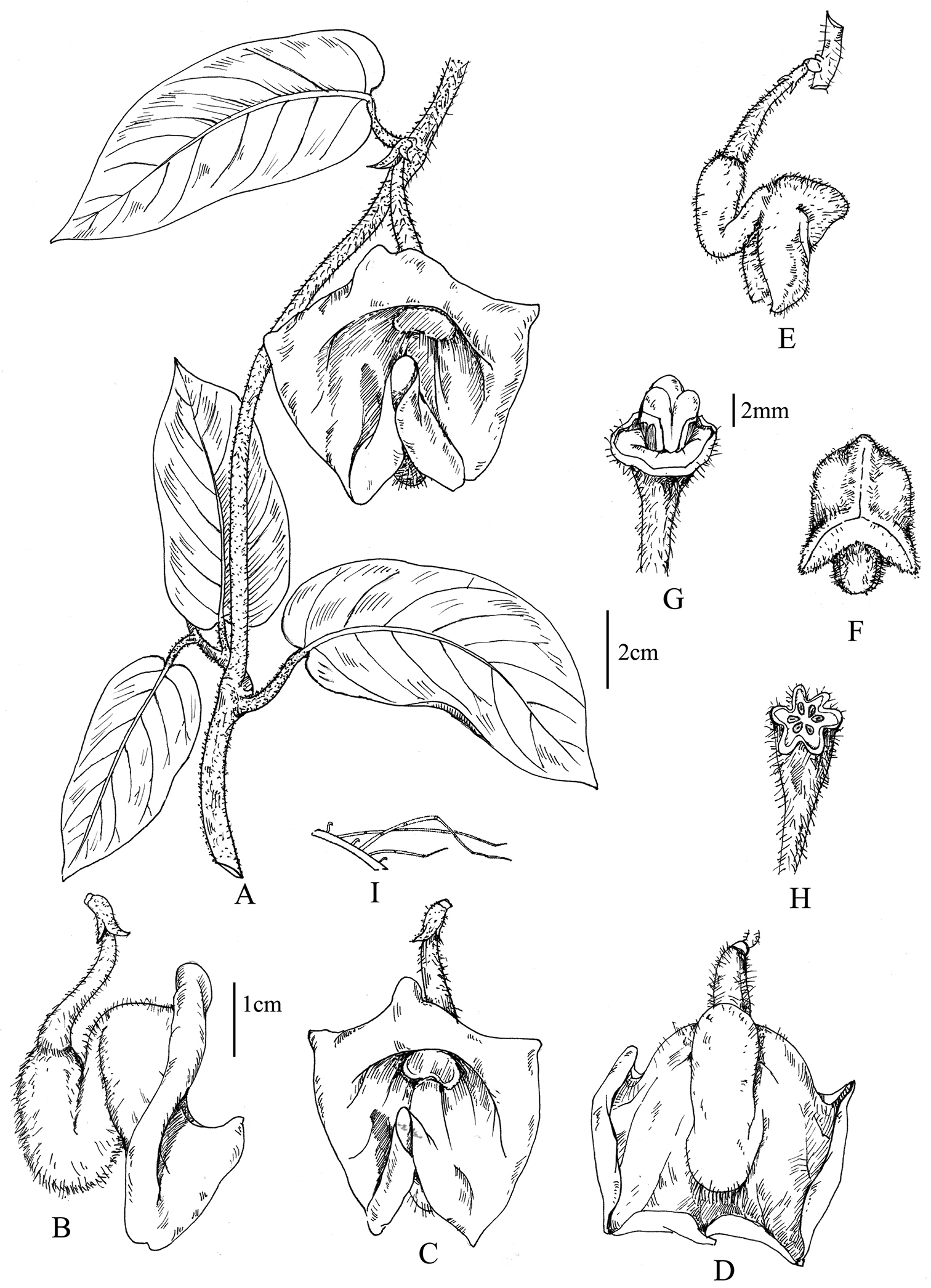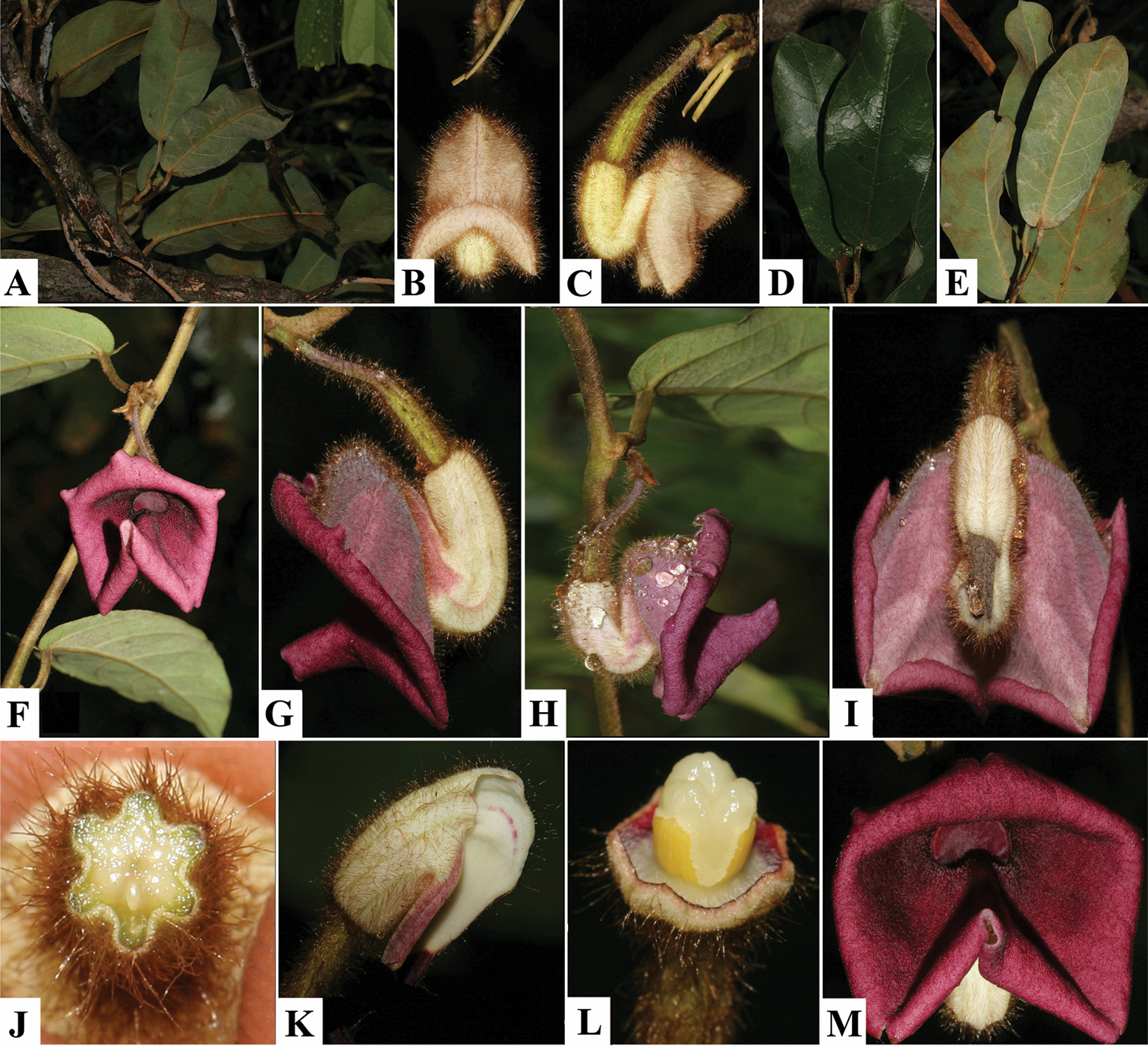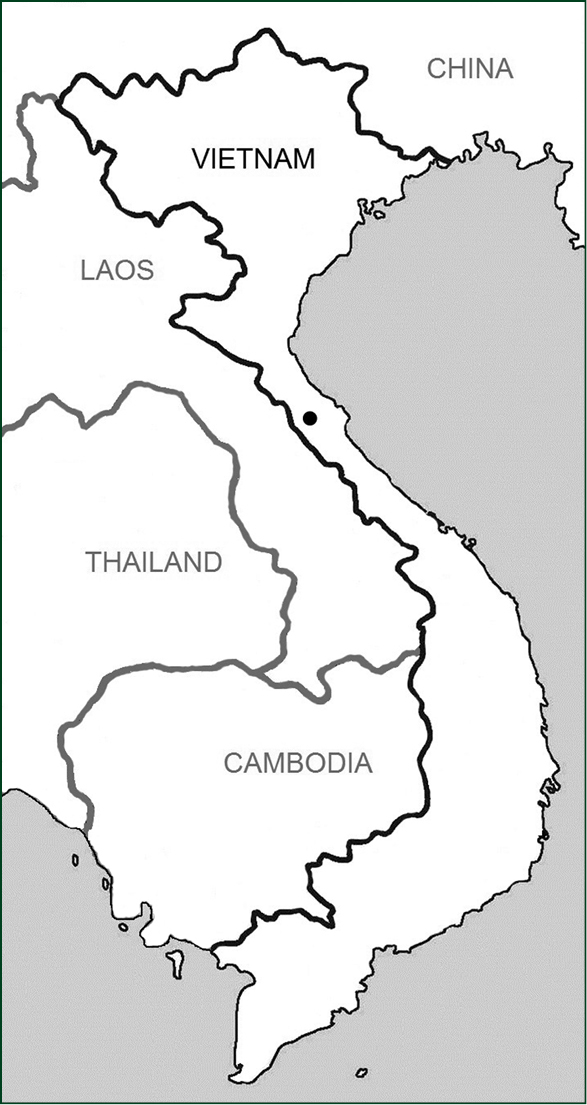






(C) 2014 Truong Van Do. This is an open access article distributed under the terms of the Creative Commons Attribution License (CC BY 4.0), which permits unrestricted use, distribution, and reproduction in any medium, provided the original author and source are credited.
For reference, use of the paginated PDF or printed version of this article is recommended.
Citation: Do TV, Nghiem TD, Wanke S, Neinhuis C (2014) Aristolochia quangbinhensis (Aristolochiaceae), a new species from Central Vietnam. PhytoKeys 33: 51–59. doi: 10.3897/phytokeys.33.6094
Aristolochia quangbinhensis T.V. Do, a new species from Central Vietnam, is described and illustrated. According to morphology, the species belongs to Aristolochia subgenus Isotrema. A detailed description, along with line drawings, photographs, ecology, distribution, conservation status as well as a comparison to morphologically similar species is provided.
Aristolochia, Aristolochia quangbinhensis, Aristolochiaceae, Isotrema, new species, Vietnam
Aristolochia comprises about 500 species and is the largest genus of Aristolochiaceae (
Isotrema is well known for its U- or horseshoe-shaped perianth, the utricle and the tube are not sharply delimited, a strongly folded or curved tube, a 3-lobed limb, sometimes with fused lobes, and a gynostemium consisting of three segments, each of them carrying two anthers on the outer surface. In contrast, subgenus Aristolochia can be recognized by its slightly curved or rectilinear tube, the utricle and the tube are sharply distinct, a one- to three-lobed perianth limb, a gynostemium with more than three lobes, each of them carrying a single anther on the outer surface. Based on these characters, the new species can be easily assigned to subgenus Isotrema.
In an illustrated Flora of Vietnam,
Based on morphological characters, a first overview of the genus Aristolochia from Vietnam and adjacent areas (southern China, Laos, Cambodia & Thailand) was prepared. All available specimens of Aristolochia housed in Vietnamese herbaria (CPNP, HN, HNU, IMM, VNM VNMN), relevant collections from institutions abroad (DR, HITBC, IBK, IBSC, K, KUN, L, MO, P, SING) and material from recent fieldwork were examined. All morphological characters were studied under dissecting microscopes, and are described using the terminology presented by
urn:lsid:ipni.org:names:77135668-1
http://species-id.net/wiki/Aristolochia_quangbinhensis
Figure 1, 2This new species is morphologically similar to Aristolochia championii Merill & W.Y. Chun, Aristolochia vallisicola T.L. Yao, Aristolochia petelotii O.C. Schmidt and Aristolochia versicolor S.M. Hwang, but is distinguishable from these species by the following diagnostic characters: petiole 1.5–2.5(–3) cm long; lamina elliptic to oblong-elliptic; peduncle 1.5–2 cm long, covered with yellow-brown trichomes; perianth limb bell-shaped, 2–2.5(–3) cm wide, exclusively purplish-pink on both sides, no blotches or veins are visible; perianth margins recurved; flower tube mouth slightly darker than the remaining perianth limb; perianth tube pale yellow to whitish and the entire back of the perianth limb and tube covered with yellow-brown trichomes.
VIETNAM. Quang Binh province: Minh Hoa district, Hoa Luong community, 17°47'5.00"N, 105°52'20.05"E, elev. 380 m, 3 April 2013, T.V. Do 39 (holotype: VNMN; isotype: DR).
Perennial woody lianas. Roots numerous, fasciculate and cylindrical. Stems terete, densely yellow-brown villous when young, older stems with corky bark, glabrous. Petiole 1.5–2.5(–3) cm long, straight, densely covered with yellow-brown trichomes; lamina elliptic to oblong-elliptic, (6–)8–13(–14) cm long, 3–5(–6) cm wide, subcoriaceous, base subcordate to auriculate, with a shallow sinus 3–4 mm deep, (1–)1.5–2 mm wide, apex acute, adaxially glabrous, dark green, abaxially densely yellow-brown villous, basal veins 3, palmate, secondary veins 7–8 pairs, pinnate, venation densely reticulate and prominent on both sides. Flowers terminal, solitary, but accompanied by a lanceolate scale-like bracteole, (2–)3 mm long, (1.5–)2 mm wide, sessile, inserted near base of the peduncle, conspicuous, persistent. Peduncles 1.5–2 cm long, pendulous, purple, densely hirsute. Peduncles, bracts and perianth densely covered by yellow-brown pluricellular hairs. Perianth S-shaped, (3–)3.2–3.5 cm long, outside densely yellow-brown hirsute with obscure, parallel veins, inside smooth. Ovary oblong, (0.8–)1–1.2 cm long, 0.3–0.4 cm diam., yellowish-green, densely hirsute, 6-locular, ovules numerous, usually in one series. Utricle ovoid, (1.2–)1.5–1.8 cm long, 0.5–0.6(–0.8) cm diam., externally white, inner surface basally with a dark-purple patch and distally with a white patch; tube strongly curved at its base, parallel and in close contact with the utricle, narrower than the utricle, cylindrical, 0.9–1.0 cm long, 0.4–0.5 cm diam.; limb three-lobed, bell-shaped, 2–2.5(–3) cm diam., purplish-pink on both sides, without any blotches or veins visible, outer surface densely hirsute, inner surface smooth, the three unequal lobes valvate in preanthetic flowers, the lateral lobes broadly deltoid with acute apex, the lower (median) lobe semicircular, during anthesis bell-shaped and with the margins recurved; throat circular, dark-purple, densely papillose; annulus present, formed by an ellipsoid flange, dark-violet; gynostemium three-lobed, lobes with obtuse apices, smooth, (3–)4–5 mm high, 2–3 mm diam., white; stamens six in one serie of three pairs; anthers oblong, (2–)2.5–3 mm long, yellow, tetralocular, longitudinally dehiscent. Capsules not seen.
Line drawing of Aristolochia quangbinhensis T.V. Do. A Flowering branch B–D Lateral (B) frontal (C) and dorsal (D) views of a flower at anthesis E–F Lateral (E) and frontal (F) views of a preanthetic flower G Gynostemium and ovary H Transverse section of ovary I Multicellular trichomes on the surface of the petiole. Drawing by N.V. Quyet from the holotype.
Photographs of Aristolochia quangbinhensis T.V. Do. A Habit B–C Frontal (B) and lateral (C) views of a preanthetic flower D–E Leaf in adaxial (D) and abaxial (E) views F Flowering branch G–I Lateral (G–H) and dorsal (I) views of flowers at anthesis J Transverse section of the ovary K Inner surface of perianth L Gynostemium and ovary M Frontal view of an anthetic flower. Photographs taken on the holotype locality in Hoa Luong community, Minh Hoa district, Quang Binh province, Central Vietnam.
Phòng Kỷ Quảng Bình (in Vietnamese).
Aristolochia quangbinhensis is known from a single population found on the north-eastern slope of a mountain range bordering the buffer zone of Phong Nha-Ke Bang National Park in the Hoa Luong community, Minh Hoa district, Quang Binh province (Fig. 3). It might also be present in Laos P.D.R., because of the proximity of the Khammouan province with Central Laos.
Distribution (dot) of Aristolochia quangbinhensis T.V. Do in Central Vietnam.
Aristolochia quangbinhensis occurs in humid mountain sites, in the understory of disturbed lowland evergreen broad-leaved forest and mainly evergreen scrubs. Dominant plants at the type locality are Annonaceae (Desmos spp.), Apocynaceae (Marsdenia spp., Wrightia spp.), Fabaceae (Millettia spp.), Lauraceae (Machilus spp., Litsea spp.), Malvaceae (Sterculia spp.), Pandaceae (Microdesmis spp.), Phyllanthaceae (Antidesma spp., Aporosa spp., Glochidion spp.), and Rubiaceae (Randia spp.).
Flowering specimens have been collected in April and May but it is possible that blooming already begins in March.
The specific epithet refers to the type locality.
In the past, large areas of primary, broad-leaved, evergreen forest covered the Hoa Luong community. Excessive logging, however, resulted in the loss of large extensions of primary forest. Although logging was prohibited in the 1990s, local farmers continued to impose strong pressure on the remaining forest patches converting it mostly into corn and soybean fields. As a result, the flora of the area should be regarded as threatened by extinction. Within the area, Aristolochia quangbinhensis is known from a single population; in fact, during the present study, only two healthy individuals were located growing about 50 m apart from each other. Therefore, the new species is assigned a preliminary status of vulnerable (VU D2) according to IUCN Red List criteria (
Aristolochia quangbinhensis is morphologically similar to Aristolochia vallisicola T.L. Yao (reported from Pahang, Peninsular Malaysia), Aristolochia championii Merr. et Chun (known from Guangdong, Guangxi, China), Aristolochia versicolor S.M. Hwang (reported from China and Thailand) and Aristolochia petelotii O.C. Schmidt (reported from Vietnam and China). However, the new species differs from the aforementioned species by several important vegetative and reproductive characters (summarized in Table 1). This new discovery, along with several new species recently described from Thailand (
Comparison between Aristolochia quangbinhensis and its four morphologically closest relatives.
| Characters | Aristolochia quangbinhensis | Aristolochia vallisicola | Aristolochia championii | Aristolochia versicolor | Aristolochia petelotii |
|---|---|---|---|---|---|
| Petiole | 1.5–2.5(–3) cm long, densely yellow-brown villous | 2.5–7 cm long, puberulent | 1–2.0 cm long, densely villous | 1–2.0 cm long, sparsely pilose | 2–4 cm long, densely yellow-brown villous |
| Lamina | elliptic to oblong-elliptic, (6 –)8–13(–14) cm long, 3–5(–6) cm wide | lanceolate, oblanceolate to broadly oblanceolate, 6.5–11 cm long, 1.7–3.9 cm wide | elliptic- lanceolate to linear-lanceolate, 15–30 cm long, 2–5 cm wide | narrowly elliptic to lanceolate-elliptic, 7.5–33 cm long, 4–12 cm wide | narrowly ovate to lanceolate ovateblade lamina, 12–20(–22) cm long, 5–11(–13) cm wide |
| Leaf base | narrowly auriculate; 3–4 mm deep | cordate; 2–3 mm deep | rounded to shallowly cordate; 2 mm deep | narrowly auriculate; 5–7 mm deep | shallowly cordate, sinus 6–10 mm deep |
| Leaf apex | acute | acute | acuminate | acute to acuminate | acuminate |
| Adaxial surface of the leaf | glabrous | glabrescent | glabrous but villous along veins | glabrous | glabrous |
| Abaxial surface of the leaf | densely yellow-brown villous | puberulent | densely brown villous | sparsely villous along veins, glaucous | pubescent |
| Inflorescences | ramiflorous, flower solitary | cauliflorous, flower solitary | cauliflorous, cluster of 2–5 flowers | ramiflorous, solitary or flower pair | cauliflorous, cluster of 2–3 flowers |
| Peduncle | 1.5–2 cm long; densely hirsute, unbranched | 15.5–17 cm long; puberulent, branched | 3–4 cm long; brown villous, unbranched | 2–3 cm long; brown villous, unbranched | 10–12 cm long, densely brown villous, unbranched |
| Perianth | yellowish-white; (3–)3.2–3.5 cm long; without blotches | purple; 6–6.5 cm long; with obscure veins | greenish-yellow; 10–12 cm long; with purple veins and blotches | yellow-green; 7–9 cm long; with purple veins | yellow-purple, 8–10 cm long; with purple veins and blotches |
| Limb | purplish-pink; bell-shaped; 2–3 cm wide; unequal 3-lobed, margin of lobes recurved, acute apex | yellow; disc-shaped; 5.8–6.5 cm wide; equal 3-lobed, margin of lobes expanded, rounded apex | yellow; funnel-shaped; 4–6 cm wide; unequal 3-lobed, lower one spreading spathulate-like, margin of lobes erect, rounded apex | purple; disc-shaped; 4–6 cm wide; equal 3-lobed, margin of lobes expansive, rounded apex | yellow; bell-shaped; 4–5 cm wide; unequal 3-lobed, margin of lobes rolled downwards, acute apex |
| Throat | annulus present, throat dark-violet | annulus present, throat coloration unknown | annulus present, throat yellow | annulus absent, throat coloration unknown | annulus present, throat dark-purple |
| Distribution | Central Vietnam | Peninsular Malaysia | Southern China | Southern China, North Eastern Thailand | Southern China, Northern Vietnam |
We thank the Vietnam National Museum of Nature (VAST) and the curators of the following herbaria for permission to study specimens: CPNP, DR, HITBC, HN, HNU, IBK, IBSC, IMM, K, KUN, L, MO, P, SING, VNM, VNMN. The first author is supported by the Erasmus Mundus program to enroll the PhD at the TU Dresden. Field work and visits to Chinese herbaria were funded through a DAAD PPP China grant to SW. We also express our sincere thanks to Mr. Quyet, Hanoi for line drawings. We very much appreciate comments and corrections by Favio González (National University of Colombia, Bogotá), and an anonymous reviewer, as well as by the editorial board. Marie-Stéphanie Samain (INECOL, Mexico) is acknowledged for final proofreading.


